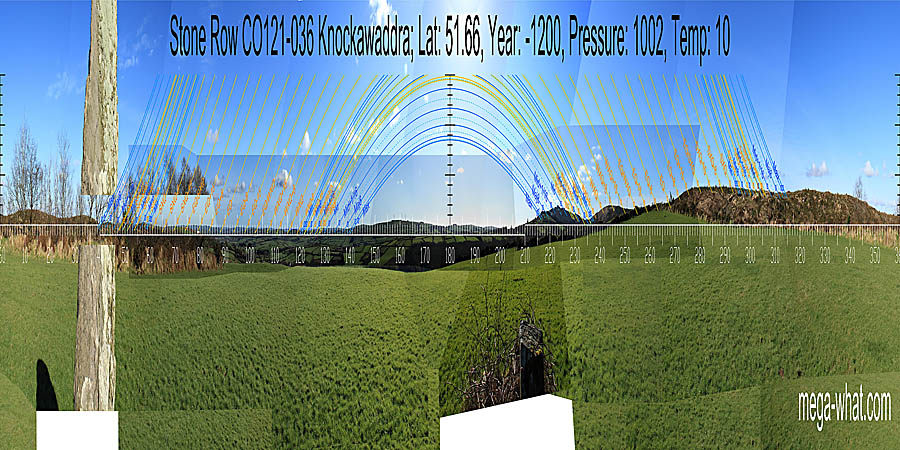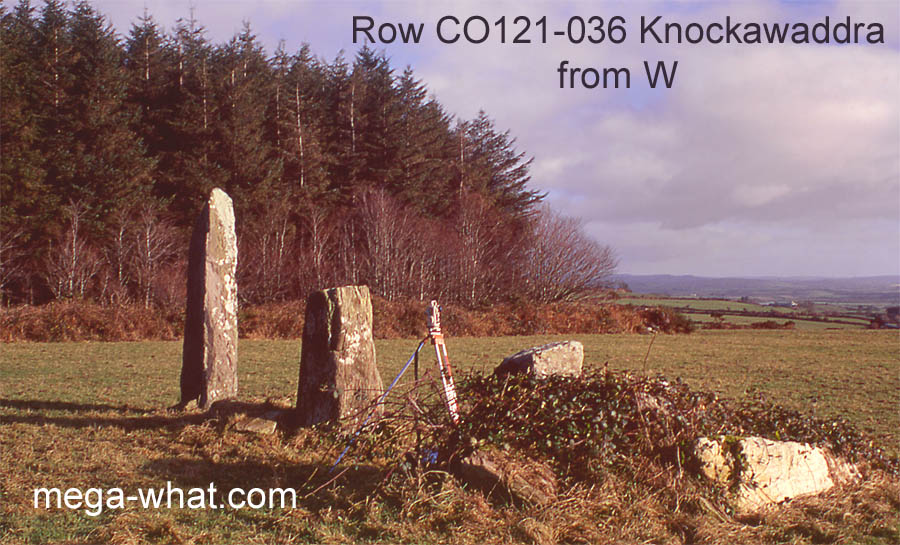 Knockawaddra Stone Row is about 2.5km south-west of Ballingurteen. Three stones, tallest to the north-east.
The forestry that used to obscure horizons from 230° right round to 80° has now (2016) been felled.
Knockawaddra Stone Row is about 2.5km south-west of Ballingurteen. Three stones, tallest to the north-east.
The forestry that used to obscure horizons from 230° right round to 80° has now (2016) been felled.
Overall orientation of the row is a few degrees beyond the major standstillsLunistice positions vary cyclically over an 18.6 year period but are fairly static for more than a year at either end of the range in both directions but individual stones do indicate them more accurately.
North is indicated by a dip [Pic].
South is indicated by a dip within a wider dip [Pic].
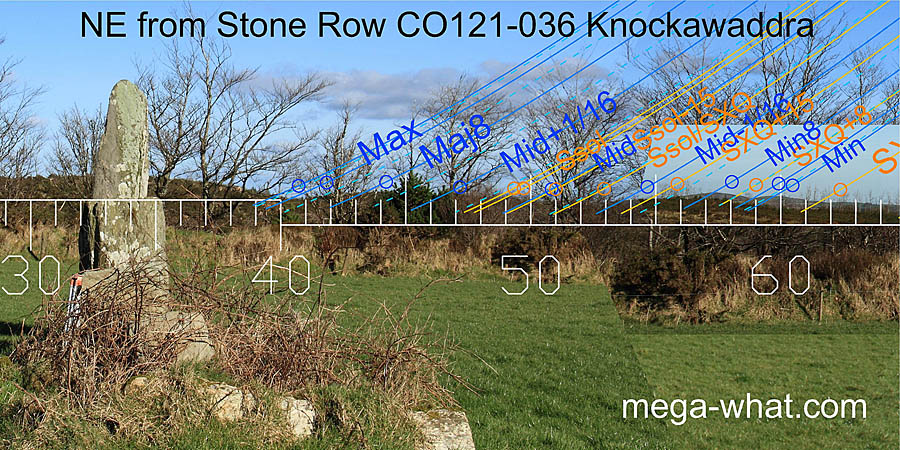 The north-eastern stone is at an angle to the row axis and indicates lunar major standstillLunistice positions vary cyclically over an 18.6 year period but are fairly static for more than a year at either end of the range
in a dip of the local ground with the major eighth on the adjacent top [Pic].
the lunar minor eighth is on a distant hilltop and minor standstillLunistice positions vary cyclically over an 18.6 year period but are fairly static for more than a year at either end of the range
is on a smaller one with summer cross-quarter at its foot.
The north-eastern stone is at an angle to the row axis and indicates lunar major standstillLunistice positions vary cyclically over an 18.6 year period but are fairly static for more than a year at either end of the range
in a dip of the local ground with the major eighth on the adjacent top [Pic].
the lunar minor eighth is on a distant hilltop and minor standstillLunistice positions vary cyclically over an 18.6 year period but are fairly static for more than a year at either end of the range
is on a smaller one with summer cross-quarter at its foot.
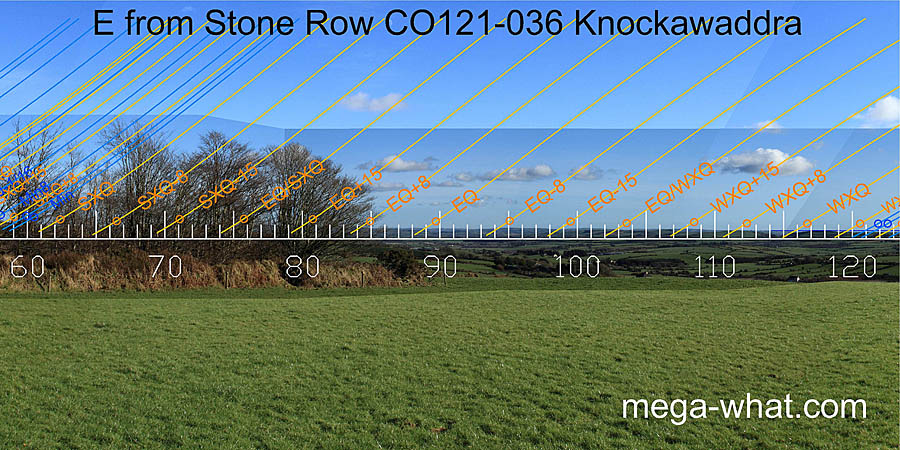 Interaction between far and nearer horizons is important to the east. The equinox is indicated by a dip above a nearer dip.
The midpoint between equinox and cross-quarter is marked by nearer ground closing with the far, to both north and south.
Winter cross-quarters are in the sea, summer cross-quarters are at the foot of the first significant hill.
Interaction between far and nearer horizons is important to the east. The equinox is indicated by a dip above a nearer dip.
The midpoint between equinox and cross-quarter is marked by nearer ground closing with the far, to both north and south.
Winter cross-quarters are in the sea, summer cross-quarters are at the foot of the first significant hill.
 To the south-east, winter cross-quarters are in a small bight of sea horizon.
The minor end of the lunisticeLunistices are the most northerly and southerly moons of the month. The lunar equivalent of solstices - more.
range is on the sea again before winter solstice sunrise on the first top.
Dip, rise, dip to the major eighth with major standstillLunistice positions vary cyclically over an 18.6 year period but are fairly static for more than a year at either end of the range
rising out of a rising slope.
To the south-east, winter cross-quarters are in a small bight of sea horizon.
The minor end of the lunisticeLunistices are the most northerly and southerly moons of the month. The lunar equivalent of solstices - more.
range is on the sea again before winter solstice sunrise on the first top.
Dip, rise, dip to the major eighth with major standstillLunistice positions vary cyclically over an 18.6 year period but are fairly static for more than a year at either end of the range
rising out of a rising slope.
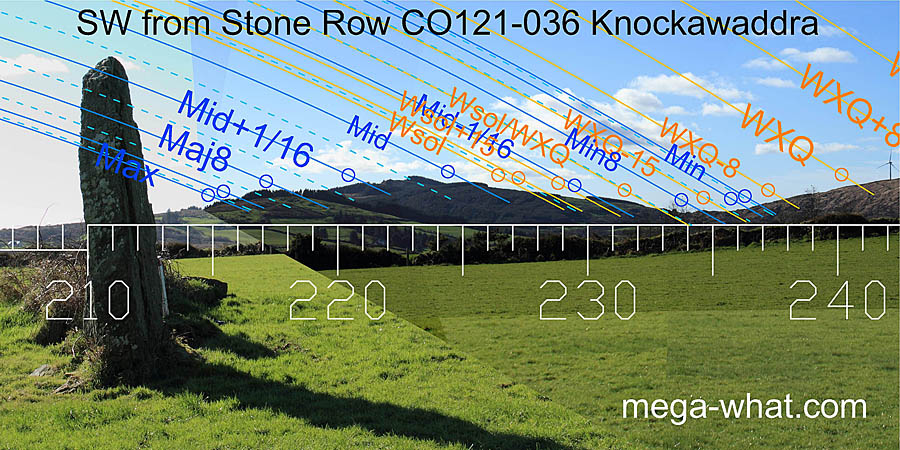 South-westwards, the intersect notch between Carrig Fadda and the smaller, rounder hill just south of it is the major eighth. the lunar minor eighth is in the north basal dip.
The major standstillLunistice positions vary cyclically over an 18.6 year period but are fairly static for more than a year at either end of the range
is more closely indicated by the south-western stone [Pic].
South-westwards, the intersect notch between Carrig Fadda and the smaller, rounder hill just south of it is the major eighth. the lunar minor eighth is in the north basal dip.
The major standstillLunistice positions vary cyclically over an 18.6 year period but are fairly static for more than a year at either end of the range
is more closely indicated by the south-western stone [Pic].
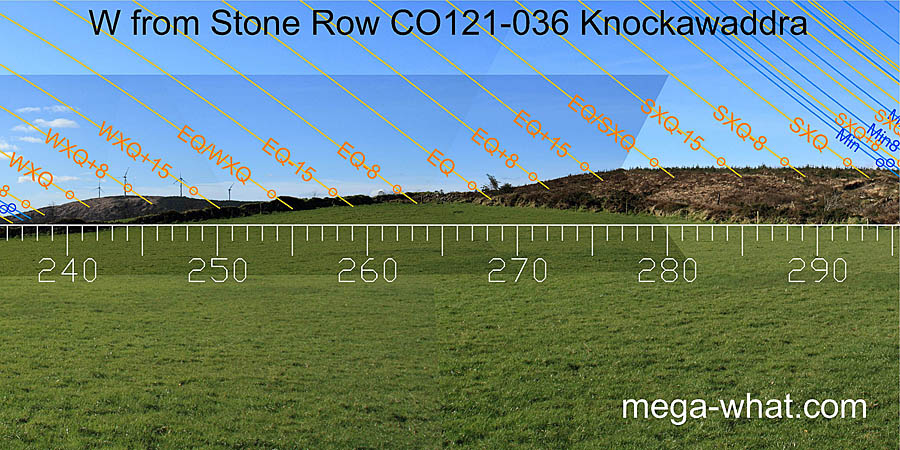 Westwards, the winter cross-quarter / equinox midpoint is in the dip formed by the intersection of distant and local ground.
The summer cross-quarter / equinox midpoint is at the crest of the local ridge with the equinox itself at the basal step.
Westwards, the winter cross-quarter / equinox midpoint is in the dip formed by the intersection of distant and local ground.
The summer cross-quarter / equinox midpoint is at the crest of the local ridge with the equinox itself at the basal step.
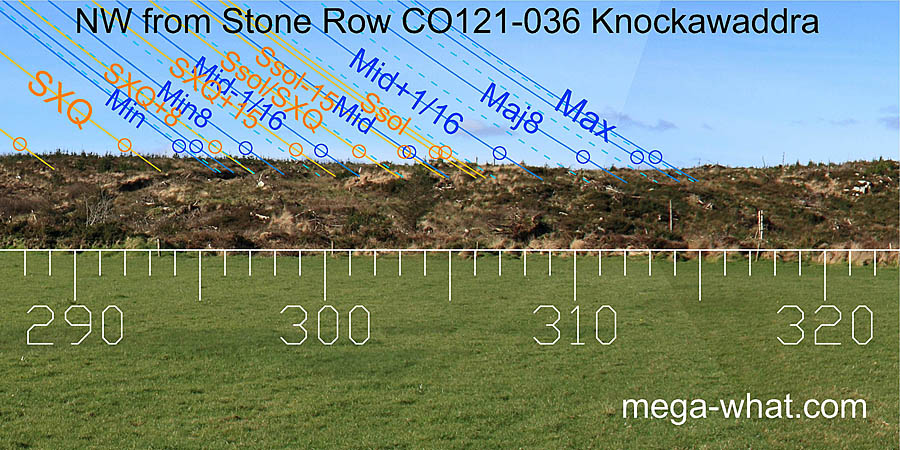 The north-western horizon is very local. It is set so that the lunisticeLunistices are the most northerly and southerly moons of the month. The lunar equivalent of solstices - more.
range runs down the slope to a dip
but major standstillLunistice positions vary cyclically over an 18.6 year period but are fairly static for more than a year at either end of the range
is just beyond the lowest point which actually marks the major eighth.
This zone is very position sensitive because it is close and so individual stone positions may well be significant.
The north-western horizon is very local. It is set so that the lunisticeLunistices are the most northerly and southerly moons of the month. The lunar equivalent of solstices - more.
range runs down the slope to a dip
but major standstillLunistice positions vary cyclically over an 18.6 year period but are fairly static for more than a year at either end of the range
is just beyond the lowest point which actually marks the major eighth.
This zone is very position sensitive because it is close and so individual stone positions may well be significant.
- Knockawaddra Standing Stone Pair is about only 200m downhill to the east but the two sites are not intervisible.
- Lettergorman Five Stone Circle is 900m to the west-south-west.
- The nearest Stone Row is Knockatlowig, 5.3km to the east-south-east and these two form a couple that are a long way from any other rows, though there is possibly another row between them, currently classified as Stone Pair CO121-066 (unsurveyed).
- Behagullane Stone Row is 11km north (02°)
References
- Archaeological Survey of Ireland, record details. www.archaeology.ie/archaeological-survey-ireland
- LYNCH, ANN 1982 Astronomy and Stone Alignments in S.W. Ireland. Archaeoastronomy in the Old World, edited by D. Heggie, pp.205-213. Cambridge: University Press.
- Ó'NUALLÁIN, SEÁN 1988 Stone Rows in the South of Ireland. Proceedings of the Royal Irish Academy 88c:179-256, p237, no.50.
- POWER, D. et al. 1992 Archaeological Inventory of County Cork, Volume 1: West Cork. Dublin: Stationary Office. p37, no.157.
- RUGGLES, C.L.N. 1999 Astronomy in Prehistoric Britain and Ireland. Newhaven & London: Yale University Press. CKR79.
- RUGGLES, C.L.N. 1996 Stone Rows of Three or More Stones in South-West Ireland. Archaeoastronomy 21 (Journal of the History of Astronomy xxvii) S55-S71.
- RUGGLES, C.L.N. & Burl, H.A.W. 1995 Astronomical Influences on Prehistoric Ritual Architecture in North-Western Europe: The Case of the Stone Rows. Vistas in Astronomy 39:517-528. Oxford: Elsevier Science Ltd.

